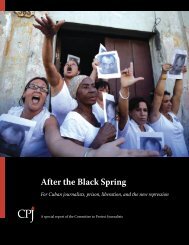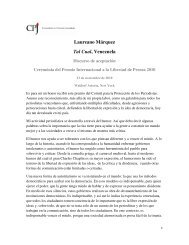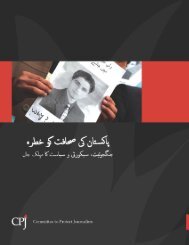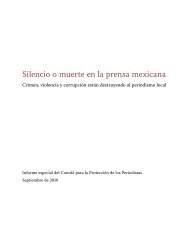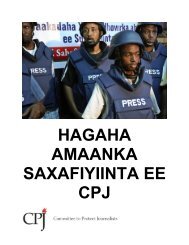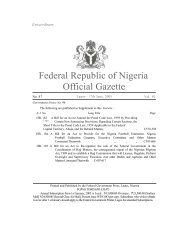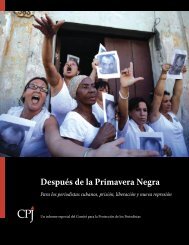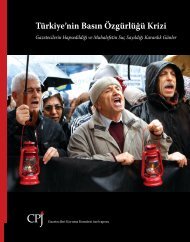Attacks on the Press - Committee to Protect Journalists
Attacks on the Press - Committee to Protect Journalists
Attacks on the Press - Committee to Protect Journalists
- No tags were found...
Create successful ePaper yourself
Turn your PDF publications into a flip-book with our unique Google optimized e-Paper software.
attacks <strong>on</strong> <strong>the</strong> press in 2009asia: pakistanNei<strong>the</strong>r offensive was militarily c<strong>on</strong>clusive, and <strong>the</strong> resp<strong>on</strong>se from <strong>the</strong> militants’side was a horrific round of suicide explosi<strong>on</strong>s, car bombs, and armed attacks.After <strong>the</strong> military moved in<strong>to</strong> South Waziristan in Oc<strong>to</strong>ber, insurgent attacksincluded a suicide bombing at <strong>the</strong> U.N. World Food Program in Islamabad;an assault <strong>on</strong> <strong>the</strong> General Headquarters of <strong>the</strong> Pakistan Army; <strong>the</strong> murders of abrigadier general and educati<strong>on</strong> minister; several market bombings in <strong>the</strong> northwesterncity of Peshawar, <strong>the</strong> worst of which <strong>to</strong>ok 100 lives; and a suicide bombing<strong>on</strong> a Peshawar office used by Pakistan’s main intelligence agency. The armyblamed most of <strong>the</strong> attacks <strong>on</strong> <strong>the</strong> Tehreek-e-Taliban, <strong>the</strong> group led by HakimullahMehsud that it was battling in South Waziristan.In July, CPJ traveled <strong>to</strong> Islamabad and Peshawar <strong>to</strong> meet with journalistscovering <strong>the</strong> military offensive in <strong>the</strong> Swat Valley. About 260 local reporters wereforced al<strong>on</strong>g with about 2 milli<strong>on</strong> o<strong>the</strong>rs from <strong>the</strong> general populati<strong>on</strong> <strong>to</strong> flee <strong>the</strong>combat areas, according <strong>to</strong> <strong>the</strong> Khyber Uni<strong>on</strong> of <strong>Journalists</strong>. Some stayed behind,but <strong>the</strong>ir coverage was severely limited by <strong>the</strong> fighting and by threats of reprisalfrom militants. The homes of at least six journalists were leveled by militants inretributi<strong>on</strong> for critical reporting. Much of <strong>the</strong> fr<strong>on</strong>t-line coverage was handled byPakistani reporters from outside <strong>the</strong> regi<strong>on</strong> who had embedded with <strong>the</strong> military.They encountered <strong>the</strong> limitati<strong>on</strong>s that embedding implies: skewed viewpoints,self-imposed censorship, and outright military c<strong>on</strong>trol of informati<strong>on</strong>. Video washeavily censored; coverage of destructi<strong>on</strong> caused by army shelling, for example,was banned.Calling its operati<strong>on</strong> “Rah-e-Rast” (or “Back <strong>on</strong> Track”), <strong>the</strong> military focusedits efforts <strong>on</strong> <strong>the</strong> NWFP’s Malakand Divisi<strong>on</strong>. In recent years indigenous localmilitant groups with links <strong>to</strong> <strong>the</strong> tribal areas had succeeded in establishingc<strong>on</strong>trol and abrogating peace treaties with successive Islamabad governments. At<strong>on</strong>e point, militant groups were in c<strong>on</strong>trol of areas <strong>on</strong>ly 60 miles (100 kilometers)from <strong>the</strong> capital. <strong>Journalists</strong> described <strong>the</strong> fighting in <strong>the</strong> Swat Valley as a“protracted low-intensity c<strong>on</strong>flict,” and several said militants c<strong>on</strong>tinued patrollingin <strong>the</strong>ir home<strong>to</strong>wns m<strong>on</strong>ths after <strong>the</strong> government had claimed success. (Severalnoted in <strong>the</strong> next breath that <strong>the</strong>y would not dare report <strong>the</strong> militant presencein bylined news s<strong>to</strong>ries for fear of retributi<strong>on</strong>.) “We still receive an<strong>on</strong>ymous teleph<strong>on</strong>ecalls, we still receive hand-written letters from <strong>the</strong> militants,” said SherShamseen Shah, president of <strong>the</strong> Peshawar <strong>Press</strong> Club. The risks facing reportersin <strong>the</strong> NWFP came in<strong>to</strong> sharp relief in December when a suicide bomber set offan explosive as he tried <strong>to</strong> enter <strong>the</strong> Peshawar <strong>Press</strong> Club. Four people were killed,including a club employee and a police c<strong>on</strong>stable. Roughly 30 journalists wereinside for a press c<strong>on</strong>ference when <strong>the</strong> bomb exploded.The sec<strong>on</strong>d military offensive, this in<strong>to</strong> Waziristan, began in mid-Oc<strong>to</strong>ber,with two army divisi<strong>on</strong>s <strong>to</strong>taling about 28,000 troops backed by local Fr<strong>on</strong>tierCorps members who joined when fighting came <strong>to</strong> <strong>the</strong>ir home<strong>to</strong>wns. The BBCand o<strong>the</strong>rs estimated <strong>the</strong> Taliban <strong>to</strong> number between 10,000 and 20,000, withseveral hundred hardened ethnic Uzbek fighters adding support. By <strong>the</strong> end ofOc<strong>to</strong>ber, <strong>the</strong> army was restricting reporters’ access <strong>to</strong> <strong>the</strong> fighting, which localresidents, relaying news by teleph<strong>on</strong>e, said had been fierce.The military did not allow reporters <strong>to</strong> embed in Waziristan until late year.“They d<strong>on</strong>’t like <strong>to</strong> take reporters in<strong>to</strong> areas until <strong>the</strong> hard part of <strong>the</strong> fighting isover,” Mazhar Abbas, deputy news direc<strong>to</strong>r at ARY News, <strong>to</strong>ld CPJ. With little orno access, local reporters used ph<strong>on</strong>es <strong>to</strong> maintain c<strong>on</strong>tact with sources and witnesses.“In Waziristan, even <strong>the</strong> local stringers aren’t reporting from <strong>the</strong>re. Theyget teleph<strong>on</strong>e reports, but <strong>the</strong>y are not <strong>the</strong>re <strong>to</strong> witness <strong>the</strong> fighting—<strong>the</strong> army<strong>to</strong>ld <strong>the</strong>m <strong>to</strong> clear out of <strong>the</strong> c<strong>on</strong>flict area,” Abbas said.<strong>Journalists</strong> <strong>to</strong>ld CPJ that <strong>the</strong> Pakistani military, while making some improvementsin media relati<strong>on</strong>s, lagged well behind <strong>the</strong> Taliban in terms of accessibilityand disseminating informati<strong>on</strong>. “The Taliban need <strong>the</strong> media, <strong>to</strong>o,” Abbas noted.“They are using text messagingt o p developments»»<strong>Press</strong> has very limited access duringtwo military offensives.»»Reporters face attacks, threats fromall sides. Four are killed.6key statisticHomes of journalists destroyedby militants in retalia<strong>to</strong>ry attacks.more than ever <strong>to</strong> push informati<strong>on</strong><strong>to</strong> journalists.” Having wagedan insurgent-style war for morethan two decades, first against<strong>the</strong> Russians and now NATO,<strong>the</strong> Taliban were media savvy, ifhardly media friendly.<strong>Journalists</strong> were hard-pressed<strong>to</strong> cover this excepti<strong>on</strong>ally dangerous,logistically challenging s<strong>to</strong>ry,which was unfolding <strong>on</strong> multiplefr<strong>on</strong>ts. Baluchistan, where Talibanoperating in Afghanistan tended <strong>to</strong> c<strong>on</strong>gregate, was removed from <strong>the</strong> fiercestactivity, but <strong>the</strong>re, <strong>to</strong>o, reporters were beaten, obstructed, and threatened. “TheBaluch nati<strong>on</strong>alists often dictate <strong>to</strong> us that <strong>the</strong>ir reports should be published insuch and such a manner,” Razaur Rahman, edi<strong>to</strong>r of <strong>the</strong> Daily Express, <strong>to</strong>ld <strong>the</strong>Internati<strong>on</strong>al Federati<strong>on</strong> of <strong>Journalists</strong>.Four journalists lost <strong>the</strong>ir lives in 2009, <strong>on</strong>e of <strong>the</strong>m during <strong>the</strong> Swat Valleymilitary offensive. Janullah Hashimzada, who worked for Shamshad TV, an Afghanstati<strong>on</strong>, was killed in <strong>the</strong> Khyber Agency in August when three gunmen ina passing car fired at <strong>the</strong> Afghan journalist and his colleague, Ali Khan, while <strong>the</strong>ywere traveling <strong>on</strong> a public minibus near <strong>the</strong> <strong>to</strong>wn of Jamrud. Hashimzada, <strong>the</strong> stati<strong>on</strong>’sPeshawar-based bureau chief for Pakistan, also reported for The Associated<strong>Press</strong>, <strong>the</strong> Pajhwok Afghan News agency, and o<strong>the</strong>r news outlets. No <strong>on</strong>e claimed132133




